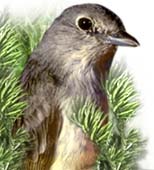|
Colorado Plateau:
Bird Inventories
at Dinosaur National Monument, Colorado and Utah
In 2001, RMBO initiated a two-year project aimed at inventorying the birds of
Dinosaur National Monument in northern Colorado and Utah. To implement the
inventory, we began work to conduct a series of breeding bird transects in each
of the monument's five primary habitats (sage shrubland, semidesert shrubland,
piņon-juniper, mixed conifer, and low-elevation riparian). Last year we
completed work in piņon-juniper and low-elevation riparian habitats.
In piņon-juniper habitat we established and conducted 21, 15-point transects
throughout the Monument using the protocol established in RMBO's Monitoring
Colorado's Birds program. Transects consisted of 15 five-minute
point counts spaced at 250-m intervals along a line. At the individual points,
observers recorded all birds seen and/or heard and the radial distance to each
bird detected.
In low-elevation riparian habitat, we established and conducted 63 one-mile line
transects by raft on the Yampa and Green rivers, and 15 kilometers of line
transects by foot in riparian habitat that could not be adequately sampled from
the river. For river transects, observers recorded all birds seen and/or heard
and the perpendicular distance to each bird from the center of the river. For
riparian transects conducted by foot, field workers visited areas with large
patches of riparian habitat (Deerlodge Park, Gates of Ladore, Echo Park, Pool
Creek, Cub Creek, Green River Campground, Rainbow Park, Jones Creek, Harding
Hole, and Laddie Park), and conducted line transects ranging from 300 m to 5000
m in length in those areas. Workers recorded all birds seen and/or heard and
the perpendicular distance to each bird from the transect line.
In the two habitat types, 3988 individual birds of 86 species were recorded on
the transects. In piņon-juniper, observers recorded 2050 individual birds of 70
species. Species with large sample sizes included Black-throated Gray Warbler
(n = 377), Gray Flycatcher (n = 204), Spotted Towhee (n = 179), Chipping
Sparrow (n = 153), Mourning Dove (n = 96), and Blue-gray Gnatcatcher (n = 89).
In low-elevation riparian, observers recorded 1938 individual birds of 59
species. Species with large sample sizes included Violet-green Swallow (n =
417), Yellow Warbler (n = 238), Lazuli Bunting (n = 215), White-throated Swift
(n = 155), Spotted Towhee (n = 102), and Spotted Sandpiper (n = 77). Notable
species that were observed in the Monument, but not detected on transects
included American White Pelican, Double-crested Cormorant, Ring-billed Gull,
Rock Dove, Western Screech-Owl, Great Horned Owl, Burrowing Owl, Common
Nighthawk, Common Poorwill, Willow Flycatcher, Eastern Kingbird, Steller's Jay,
Blackpoll Warbler, and American Goldfinch.
In order to get a more-balanced view of the bird species visiting the Monument
during non-breeding seasons, we will conduct informal birding surveys during
fall, winter, and spring. Thus work for the 2002 season began with informal
winter birding. Work during the late spring and summer will complete the
breeding bird surveys in the other three major habitats in the Monument (sage,
semidesert/grassland, and mixed conifer). We will conduct point transects or
line transects through each of those habitats. During the fall, we will conduct
informal birding surveys in order to obtain data not covered by the transect
methodologies aimed at breeding species. We will also visit rare habitats
(Ponderosa Pine, Aspen) and conduct informal surveys of the bird species
present. Our initial season at Dinosaur went very well, and we are excited to
begin work again this spring. A final report on our findings will be submitted
to the National Park Service December 2002.
For More Information:
glenn.giroir@rmbo.org
337 25 3/4 Road
Grand Junction, CO 81503
(970) 241-4674
|



